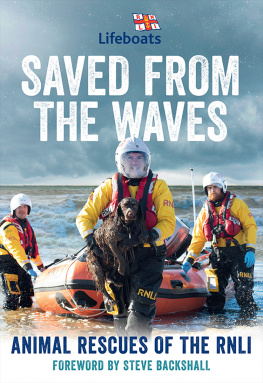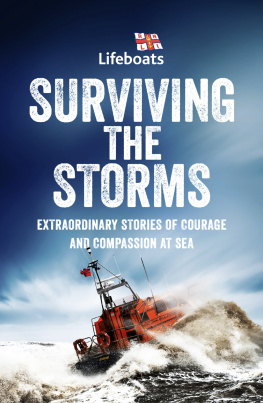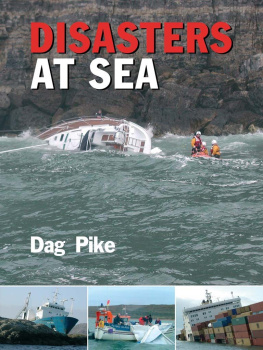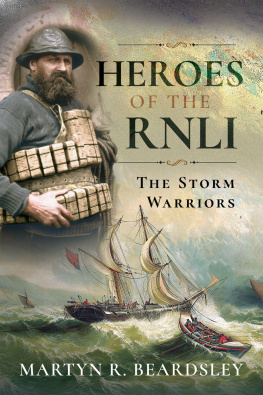A minimum of 8,000 from the sale of this book will be paid in support of the RNLI. Payments are made to RNLI (Sales) Ltd, which pays all its taxable profits to the RNLI, a charity registered in England and Wales (209603), Scotland (SC037736), the Republic of Ireland (20003326), the Bailiwick of Jersey (14), the Isle of Man (1308 and 006329F) and the Bailiwick of Guernsey and Alderney, of West Quay Road, Poole, Dorset BN15 1HZ.
The stories in this book are based on the individuals recollection of RNLI shouts. The RNLI, authors and publishers cannot be held responsible for any errors and omissions that may be found in the text. The crew members featured all followed RNLI training and operational procedures that were in place at the time. These are written with the safety of our crews and lifeboats in mind and are subject to change so the actions described in this book might not follow todays procedures.
HarperCollinsPublishers
1 London Bridge Street
London SE1 9GF
www.harpercollins.co.uk
HarperCollinsPublishers
1st Floor, Watermarque Building, Ringsend Road
Dublin 4, Ireland
First published by HarperCollinsPublishers 2022
FIRST EDITION
Text RNLI 2022
Cover design by Sim Greenaway HarperCollinsPublishers Ltd 2022
Jacket photographs RNLI/Nathan Williams and Shutterstock. com
RNLI name and logo are trademarks of RNLI used by HarperCollinsPublishers Limited under licence from RNLI (Sales) Ltd
A catalogue record of this book is available from the British Library
Nikki Croft-Girvan asserts the moral right to be identified as the author of this work
All rights reserved under International and Pan-American Copyright Conventions. By payment of the required fees, you have been granted the nonexclusive, non-transferable right to access and read the text of this e-book on screen. No part of this text may be reproduced, transmitted, downloaded, decompiled, reverse engineered, or stored in or introduced into any information storage retrieval system, in any form or by any means, whether electronic or mechanical, now known or hereinafter invented, without the express written permission of HarperCollins e-books.
Find out about HarperCollins and the environment at
www.harpercollins.co.uk/green
Source ISBN: 9780008485962
Ebook Edition April 2022 ISBN: 9780008485979
Version: 2022-02-28
This ebook contains the following accessibility features which, if supported by your device, can be accessed via your ereader/accessibility settings:
- Change of font size and line height
- Change of background and font colours
- Change of font
- Change justification
- Text to speech
- Page numbers taken from the following print edition: ISBN 9780008485962
This book is dedicated to the animals loved, lost and rescued and the people who have cared for them.
by Steve Backshall
I have always been grateful to the RNLI. My career as a wildlife broadcaster and my passion for marine life have often taken me onto and into the water around our coasts. I quickly came to realise what the sea is capable of and how quickly conditions can change. To know that there are these skilful, courageous volunteers ready to launch to your rescue at a moments notice is incredibly reassuring and humbling when youre afloat or diving.
But theres another reason why I admire the RNLIs lifesavers. I love the fact they are prepared to preserve the lives of animals as well as human beings. That principle has always been important to me, ever since I was a child. We lived in a smallholding, surrounded by animals that my parents had rescued. Their approach to conservation that all life is precious shaped my values and my career.
As youll discover in these pages, the RNLIs crews and lifeguards have gone to the aid of all sorts of wild animals over the years, from seabirds and deer to a humpback whale. Theres a fascinating range of stories waiting for you, and if you love animals I know youll really enjoy reading this book. Its also wonderful to know that it will help to raise the funds that equip and train the lifesavers, ready for the next rescue.
by Mark Dowie, Chief Executive of the RNLI
To save every one this is our vision at the RNLI. When our volunteer crews and lifeguards head to a lifeboat station or a beach patrol, they are driven to rescue every person at risk from drowning not just some of them. These remarkable women and men keep people safe across the UK and Ireland, whether the call for help comes from inland waterways, beaches or the open sea. In fact, RNLI crews and lifeguards have saved more than 142,500 human lives since the charity was founded in 1824 from swimmers and surfers to sailors and fishing crews.
Occasionally, our lifesavers are called to rescue animals. They respond for two reasons: one, because they are decent folk who feel compelled to save pets, livestock and wildlife as well as their fellow humans. But theres a humanitarian reason too. If a pet owner, farmer or concerned passer-by knows that a creature is in difficulty, theres a chance that they will enter the water to attempt a rescue themselves. As a dog owner, I can identify with anyone who would instinctively head into the water to rescue their cherished pet my own dog Toby was fortunately rescued by the RNLI a few years ago. But these animal rescues can and have led to tragedy. As such, many of the rescues youll read about in this book have indirectly saved human lives.
Whatever the rescue and whoever needs our help, the RNLI will respond, provided our lifesavers have the kit, training and support to keep them ready. That is impossible without the income that ensures our charity remains afloat. Thank you for buying this book and supporting the RNLI. It makes you a lifesaver too.
As told by Jacqui Palmer, Heritage Development Manager, Cromer

In the late 1920s and 30s the small coastal town of Cromer was something of a magnet for British holidaymakers. Its beachfront was a picture-postcard scene come to life, with waves breaking gently on the golden sand, children in tin boats excitedly netting shrimps in the shallows and men relaxing in striped deckchairs as the smell of fresh Cromer crab wafted on the breeze.
This idyllic scene, set against the backdrop of grand Edwardian seafront hotels, would play out daily under the watchful eye of the Cromer lifeboat crew. Despite its undeniable beauty, the coastline at Cromer was renowned for its darker side. Its unpredictable and powerful tides, winds, currents and rock-hard sandbanks had claimed thousands of lives over the years.
For this reason, the towns lifeboat crew were respected and celebrated, and when their vessel, the H. F. Bailey, was on display, it was an attraction in itself. Locals and tourists alike would stroll along to marvel at her.
As they did so, more often than not, the boat would be flanked by a man in a flat cap with a large shaggy grey dog sat contentedly at his side.
The mans name was Henry Blogg and he was coxswain at RNLI Cromer. Henry had joined the crew at the age of 18 in 1894 and 15 years later won the vote to become coxswain, but the sea had been in his blood long before then. At 11 he had left school to work on his familys crab boat. When he wasnt out at sea, he could be found on the beach, hiring out bathing dresses and towels for a penny a piece.














